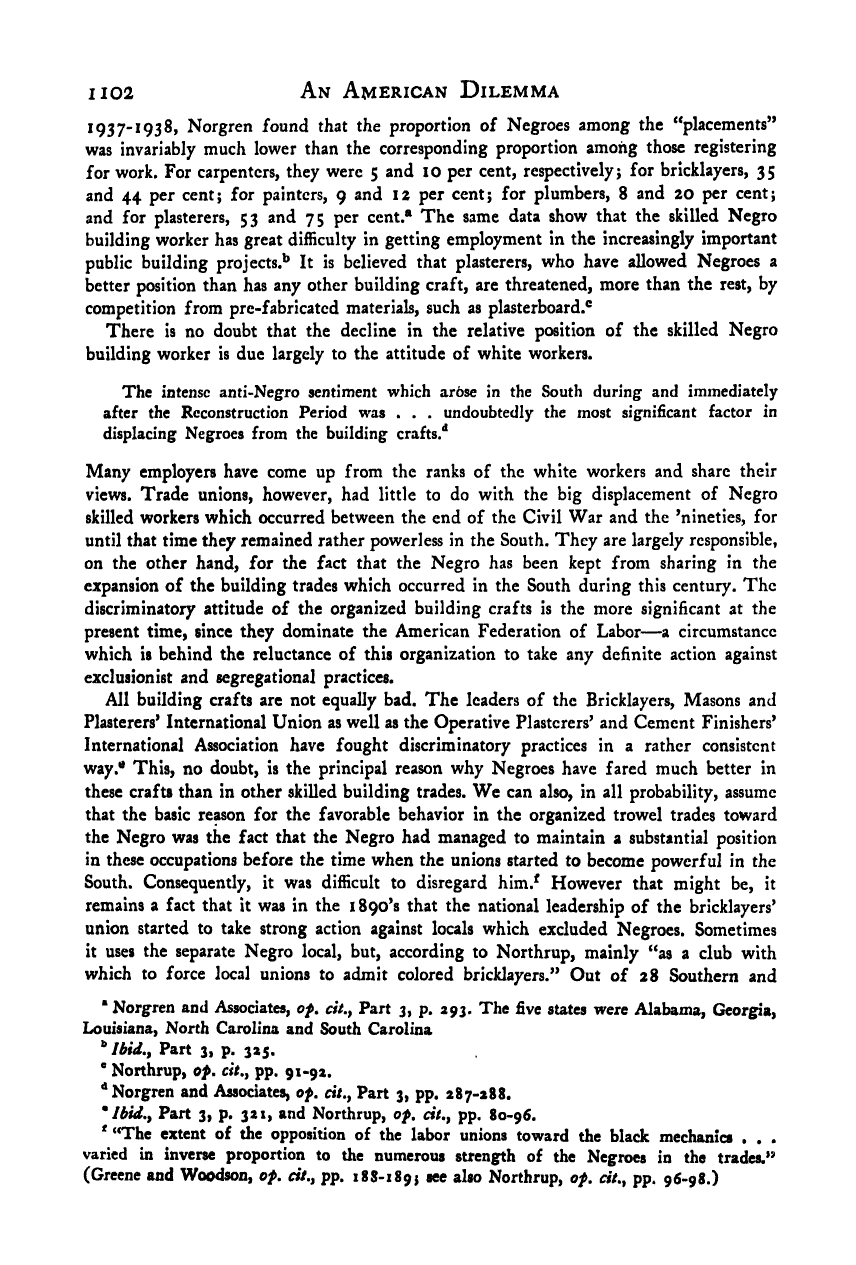Note: Gunnar Myrdal died in 1987, less than 70 years ago. Therefore, this work is protected by copyright, restricting your legal rights to reproduce it. However, you are welcome to view it on screen, as you do now. Read more about copyright.
Full resolution (TIFF) - On this page / på denna sida - Appendices - 6. Pre-War Conditions of the Negro Wage Earner in Selected Industries and Occupations - 8. Building Workers

<< prev. page << föreg. sida << >> nästa sida >> next page >>
Below is the raw OCR text
from the above scanned image.
Do you see an error? Proofread the page now!
Här nedan syns maskintolkade texten från faksimilbilden ovan.
Ser du något fel? Korrekturläs sidan nu!
This page has never been proofread. / Denna sida har aldrig korrekturlästs.
1102 An American Dilemma
1937-1938, Norgren found that the proportion of Negroes among the “placements”
was invariably much lower than the corresponding proportion among those registering
for work. For carpenters, they were 5 and 10 per cent, respectively; for bricklayers, 35
and 44 per cent; for painters, 9 and 12 per cent; for plumbers, 8 and 20 per cent;
and for plasterers, 53 and 75 per cent.® The same data show that the skilled Negro
building worker has great difficulty in getting employment in the increasingly important
public building projects.** It is believed that plasterers, who have allowed Negroes a
better position than has any other building craft, are threatened, more than the rest, by
competition from pre-fabricated materials, such as plasterboard.®
There is no doubt that the decline in the relative position of the skilled Negro
building worker is due largely to the attitude of white workers.
The intense anti-Negro sentiment which arose in the South during and immediately
after the Reconstruction Period was . . . undoubtedly the most significant factor in
displacing Negroes from the building crafts.**
Many employers have come up from the ranks of the white workers and share their
views. Trade unions, however, had little to do with the big displacement of Negro
skilled workers which occurred between the end of the Civil War and the ’nineties, for
until that time they remained rather powerless in the South. They are largely responsible,
on the other hand, for the fact that the Negro has been kept from sharing in the
expansion of the building trades which occurred in the South during this century. The
discriminatory attitude of the organized building crafts is the more significant at the
present time, since they dominate the American Federation of Labor—a circumstance
which is behind the reluctance of this organization to take any definite action against
exclusionist and segregational practices.
All building crafts are not equally bad. The leaders of the Bricklayers, Masons and
Plasterers’ International Union as well as the Operative Plasterers’ and Cement Finishers’
International Association have fought discriminatory practices in a rather consistent
way.® This, no doubt, is the principal reason why Negroes have fared much better in
these crafts than in other skilled building trades. We can also, in all probability, assume
that the basic reason for the favorable behavior in the organized trowel trades toward
the Negro was the fact that the Negro had managed to maintain a substantial position
in these occupations before the time when the unions started to become powerful in the
South. Consequently, it was difficult to disregard him.^ However that might be, it
remains a fact that it was in the 1 890’s that the national leadership of the bricklayers’
union started to take strong action against locals which excluded Negroes. Sometimes
it uses the separate Negro local, but, according to Northrup, mainly “as a club with
which to force local unions to admit colored bricklayers.” Out of 28 Southern and
* Norgren and Associates, of, cil,, Part 3, p. 293. The five states were Alabama, Georgia,
Louisiana, North Carolina and South Carolina
^ Ibid,, Part 3, p. 325.
Northrup, of, cit,, pp. 91-92.
•*
Norgren and Associates, of, cit,, Part 3, pp. 287-288.
* Ibid,, Part 3, p. 321, and Northrup, of, cit,, pp, 80-96.
<< prev. page << föreg. sida << >> nästa sida >> next page >>